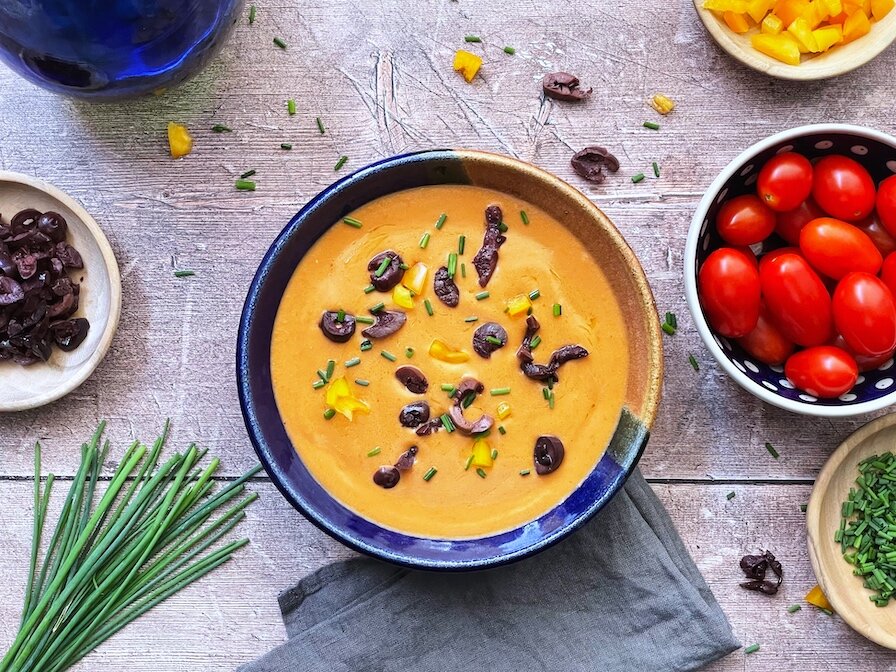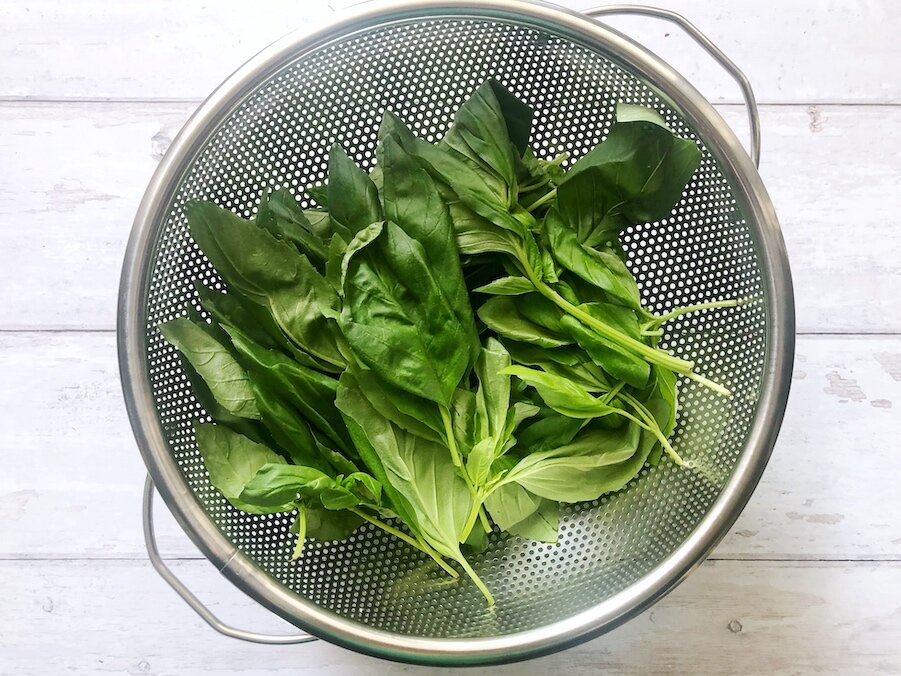Gazpacho
GLUTEN FREE · DAIRY FREE · VEGAN · PALEO · NUT FREE
(This post contains affiliate links.)
“Summer” and “soup” aren’t exactly words you tend to hear strung together very often. After all, not many people want a bowl of piping hot soup on a piping hot day. But this soup is served chilled and is bursting with refreshing summery flavours, and what’s more, it just happens to be incredibly easy to throw together. You literally just need a blender!
Gazpacho is a traditional Spanish recipe, and it’s been part of my summers for as long as I can remember. Yes, that’s right, I’m meddling with another of mama’s recipes again! It was actually a lot harder to put the recipe together than I anticipated because, after making it for the last 4,000 years or so, mama don’t use no measurements! It’s all by eye and by taste. So, it took some hardcore experimentation, calculations and note-taking to actually get the thing written down on paper. It also took some bare-faced cheek on my part, to make a few little tweaks here and there to bring it in line with Good Gut Feelings recipe requirements. And finally, it required some major scaling-down as, around here, Gazpacho is one of those big batch-cooking recipes. Some very rusty math skills were involved in getting the quantities down from “enough to feed a not-so-small army” to “just enough to ensure leftovers the next day”!
So, as we are currently smack dab in the all-consuming heat and humidity of summertime, why not treat yourself to some delicious and nutritious Gazpacho? It’s actually extremely summer-appropriate as, thanks to the high water content of several of its ingredients (I’m talking about you, Messrs Tomato, Pepper and Cucumber), it’s exceptionally hydrating, thus making it the perfect hot-summer dish! Indeed, there is evidence that ‘eating your water’, by consuming water-containing fruits and vegetables, is actually more effective at hydrating the body than drinking plain water.
Works for me!
INGREDIENTS
Tomatoes
Tomatoes are of course at the heart of Gazpacho. They are very hydrating, their water content is clear as soon as you cut or bite into them! Technically a fruit and not a vegetable, tomatoes are rich in fibre, potassium, folate and vitamins C and K. They are also a great source of lycopene, a well-known antioxidant.
You can use any tomatoes for this recipe, but I find that plum tomatoes (also sometimes known as Roma tomatoes) work the best. You don’t need to peel or de-seed them either, especially if your blender is powerful, but you absolutely can if you prefer, it’s entirely up to you.
Cucumber
With their very high water content, cucumbers are one of the most hydrating vegetables out there. In fact, it has been said that a cucumber can produce similar hydration levels to twice the volume of water.
In addition to their high water content, cucumbers are also rich in nutrients, and contain anti-inflammatory compounds.
Red pepper
While traditional Gazpacho recipes tend to call for green peppers, you can use any colour bell peppers for this recipe. Of all the colours, green peppers tend to be a bit harder to digest, due to the fact that they are essentially unripe (hence the green colour). As a result, I have a preference for red peppers, both for the slightly sweeter flavour, and because it contributes to the resulting colour of the soup. [I had actually run out of red peppers for the batch photographed here and went with orange, hence the less red colour in the photos].
Bell peppers are composed of mainly water, so are very hydrating and are rich in Vitamin C and other antioxidants.
Peppers (like tomatoes) belong to a family of vegetables known as “nightshades”. Some people are sensitive to these veggies, and they are removed from specific anti-inflammatory dietary protocols like the AIP diet for this reason. However, if there is no nightshade sensitivity, they can make a really excellent addition to a healthy diet.
Garlic
Garlic elevates both the flavour and the immune-supporting properties of any dish. It also has powerful anti-microbial and anti-fungal properties, and acts as a prebiotic by promoting the growth of beneficial bacteria in the gut.
Spring onion
Spring onions, green onions, scallions - many names for this fresh-tasting ingredient, which also just happens to need a lot less chopping effort than a regular onion: bonus!
Basil
Tomatoes’ perfect partner, basil is used here just as a flavour enhancer, and is not at all overwhelming in the resulting flavour. It’s literally just used here as part of the amalgamation of the many Gazpacho flavours!
A member of the mint family, basil is rich in nutrients including Vitamin A, Vitamin K, potassium and magnesium.
It has strong anti-inflammatory properties, and one component of its natural volatile oils (called eugenol) actually inhibits the very same enzyme in the body as many non-steriodal anti-inflammatory medications (NSAIDs), such as aspirin and ibuprofen.
Basil also has anti-bacterial properties, and its flavonoids have an antioxidant action in the body, offering protection at the cellular level, thus guarding against damage from free radicals.
Apple cider vinegar
Apple cider vinegar is always my first choice of vinegar, both because I just love the taste, but also, it’s a health food in its own right, due to its alkalizing, antimicrobial and antioxidant effects.
Traditionally, sherry vinegar, or white wine vinegar, is used for Gazpacho, but I wanted to try it with ACV as part of the ‘healthification’ process, and found it to work really well!
Extra virgin olive oil (EVOO)
A Mediterranean Diet staple, cold-pressed Extra Virgin Olive Oil is the mother of all olive oils, and definitely what you should be opting for when eating for health. Rich in healthy monounsaturated fats, it is well-established as a superfood and a key component to a healthy diet.
Olive oil also contains oleic acid, which has anti-inflammatory properties and may even have positive effects on certain genes that have been linked to cancer.
You really do want to go with EVOO, rather than a cheaper, more refined variety of olive oil, as it retains the olives’ antioxidants and bioactive compounds. Cold-pressed is important too, as it means the good stuff won’t have been destroyed by heat. Make sure to check product labels before you buy, to ensure what you’re getting really is pure extra virgin olive oil, as many that make the EVOO claim are actually diluted with other refined oils, so it’s always a good idea to check the ingredients.
Cold water
Gluten-free breadcrumbs
The addition of breadcrumbs is mainly for the texture of the Gazpacho, and it somehow helps to bind all the flavours together as well. I’ve tried this recipe without breadcrumbs and it just wasn’t the same.
You can make your own by simply putting slices of gluten-free bread (slightly dry or even ‘stale’ works best, or you can just dry it out a little in the toaster/oven first) into a food processor or blender and blitzing until you are left with breadcrumbs.
Alternatively, you can find ready-made gluten-free breadcrumbs.I used Schär Pan Grati (get it on Amazon.com or Amazon UK).
Tomato passata/tomato purée
Passata is essentially puréed raw tomatoes that have been passed through a sieve to get rid of chunks, skins and seeds. You can find this ready-made in jars (ideally opt for organic versions), or you can make your own.
Sweet paprika
Salt & pepper
Toppings options:
There is a virtually endless choice when it comes to your Gazpacho toppings. These are some of my favourites -
Kalamata olives
Peppers
Cucumber
Spring onion
Chives
Gluten-free croutons (store-bought or homemade)
Tabasco
CHANGES & SUBSTITUTIONS
Make it low-FODMAP?
This Gazpacho can be made low-FODMAP with just a few easy tweaks:
Leave out the garlic.
Use only the green tips of the spring onions (which are low-FODMAP), or leave them out altogether.
Check the ingredients of your breadcrumbs and croutons. Gluten-free products can be low-FODMAP but it will depend on the various ingredients included. If in doubt, you can of course leave them out altogether.
TIPS
Taste as you go
Don’t get too caught up in the exact ingredients and their quantities, this recipe is very forgiving and absolutely lends itself to tasting-as-you-go, both in terms of the overall flavour, but also in terms of texture (some prefer a more thick-textured soup while others like it better at a more ‘“drink-like” consistency).
Make it in advance
Gazpacho is one of those recipes that tastes better the next day, the flavours just fuse together somehow, creating something even more delicious than what you created in your blender. As such, I would recommend you make it the day before and keep in the fridge until you need it.
You can also batch-freeze it, and when you want it, simply allow it to defrost at room temperature and blend again before serving.
Serve chilled!

GAZPACHO
Ingredients
- 6 large ripe tomatoes
- 1 large red pepper, de-seeded
- 1 medium-sized cucumber
- 3 garlic cloves
- 2 spring onions
- 5 large basil leaves, fresh
- 1/2 Tbsp apple cider vinegar
- 3 Tbsp extra virgin olive oil
- 3 cups cold water
- 1 cup gluten-free breadcrumbs
- 1/2 cup tomato passata
- 1/2 tsp sweet paprika
- salt & pepper
- Kalamata olives, de-stoned & cut into ribbons
- coloured bell peppers, diced
- chives, finely chopped
- spring onions, finely chopped
- cucumber, diced
- gluten-free croutons
- tabasco
Instructions
- Start by adding the tomatoes to your blender and blend until smooth.
- Add in the rest of the ingredients, and blend until creamy and smooth, tasting as you go (you may need to add 1 or 2 ingredients at a time and blend in between if your blender is on the smaller side). Feel free to add a little more or less of things as you blend and taste, so that you get the flavours just how you like them.
- Pour the soup into an airtight container and store in the refrigerator (ideally overnight).
- Serve chilled, with your choice of toppings sprinkled on top!







